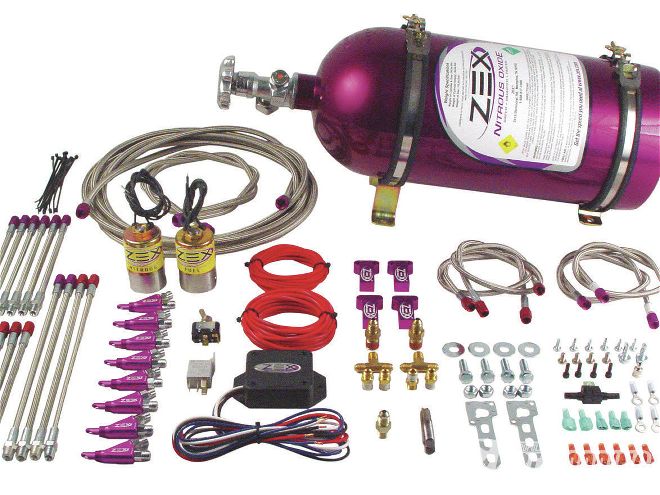
“We’ll either make 700 hp, or we’ll end up with seven pistons!” quipped Ben Strader, head honcho over at EFI University as he and master tuner Brian Macy of Horsepower Connection decided on the tune for our final nitrous dyno run of the day. The statement was an inside joke based on something a customer had once said to Brian, but the real joke is that nitrous gets a bad rap among the uninitiated—one that’s totally undeserved. Nitrous doesn’t destroy engines, bad tuning and getting greedy do.
What we mean is that just like any significant power upgrade, making the most out of nitrous is dependent upon optimum tuning and fuel choice. When wielded properly, nitrous is amazing sauce for turning even the most mundane stock engine into a fire breather. In the hands of a pro with the right supporting parts, the results can be phenomenal, and we’re going to prove it.
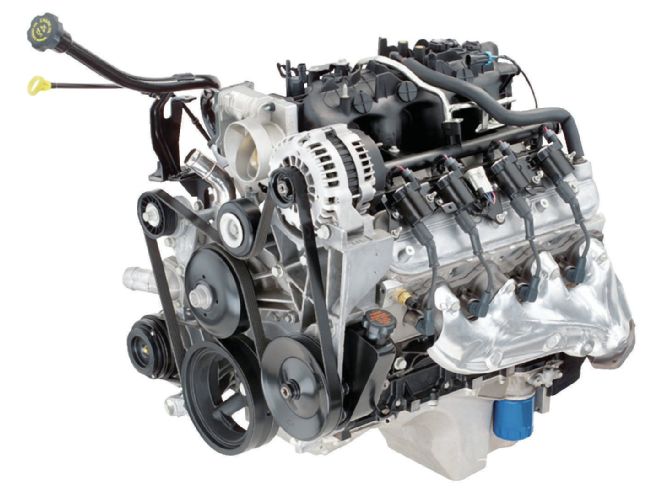 Our test subject is a ’03 LQ4 from a 2500 series truck (similar to this one) with 198,000 miles on it. If you can’t find one of these for around $700-$1,100, keep trying. We did a leakdown test on ours and saw around 15 percent. Should be nice and loose with some hearty ring gap that will help us out.
Our test subject is a ’03 LQ4 from a 2500 series truck (similar to this one) with 198,000 miles on it. If you can’t find one of these for around $700-$1,100, keep trying. We did a leakdown test on ours and saw around 15 percent. Should be nice and loose with some hearty ring gap that will help us out.
We couldn’t have asked for a better brain trust to make this test a screaming success: Ben Strader from EFI University, Macy of Horsepower Connection (who also teaches the FAST XFI class for EFI University), Don Bonahoom engine builder and nitrous racer (he runs RPM Performance), and Tom Orseno, seasoned engine builder and dyno operator at Pro Marine. If ever there was a crew who knew how to pull more power from an engine than it should be able to make, it’s these guys. Matter of fact, we made more horsepower per total dollar invested than we’ve ever done before. It’s official: A properly tuned nitrous system is the best bang for the horsepower buck you can buy.
You want to know the biggest surprise of all? With our very effective little combo, the ZEX nitrous system over-delivered on the promised horsepower and torque on every test we ran. We’ve literally never tested any combo that gave so much horsepower return on investment. And the torque? Well, you’ll just have to see the charts to believe it. Let’s just say it would put most muscle cars with decent suspension in the 9s on sauce while still being a perfectly reliable stock engine that returned respectable fuel economy in naturally aspirated form. This may be the ultimate answer to a budget LS-based street/strip package.
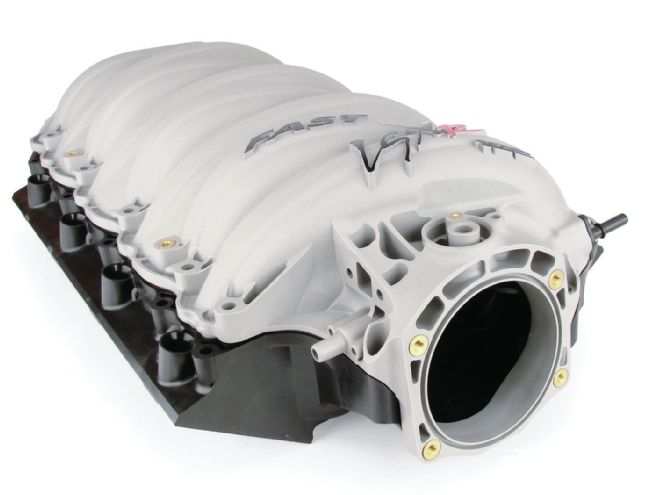 Unlike forced-induction power adders, we’re not shoving anything into the engine, so we have to make the LQ4 the most efficient air pump it can be or we’ll never see the potential of the stock long-block. Here’s the card up our sleeve for making big power on a junkyard truck engine: FAST’s LSXR intake (PN 146302, $953.95). We also used FAST’s billet fuel rails (PN 146032-KIT, $190.95) since we needed a return-style system.
Unlike forced-induction power adders, we’re not shoving anything into the engine, so we have to make the LQ4 the most efficient air pump it can be or we’ll never see the potential of the stock long-block. Here’s the card up our sleeve for making big power on a junkyard truck engine: FAST’s LSXR intake (PN 146302, $953.95). We also used FAST’s billet fuel rails (PN 146032-KIT, $190.95) since we needed a return-style system.
“We’ll either make 700 hp, or we’ll end up with seven pistons!” —Ben Strader, EFI University
Baseline Dyno Test
To establish what our factory 325 hp/360 lb-ft rated LQ4 had to offer, our first run was a naturally aspirated baseline, but with the FAST intake and throttle body instead of the stock pieces. Without dyno testing the stock intake and throttle body, it’s hard to quantify how much the FAST intake and throttle body are really worth, but using the GM factory rating for comparison, we get 92 hp and 89.1 lb-ft of torque. It’s probably worth at least half that amount for sure.
6.0L LS LQ4 FAST Intake Only
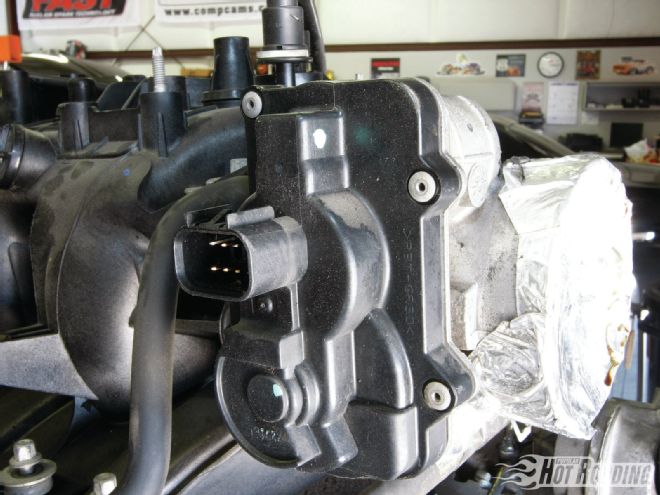 We want to stay as stock as possible, but we also want to make big power on nitrous. Our biggest impediment is the LQ4 truck intake, so it’s the one part we’re going to swap. We cheated a little bit by discarding the tall, torque-biased truck intake, but the electronically controlled throttle body was our biggest reason—it can’t be controlled on the dyno.
We want to stay as stock as possible, but we also want to make big power on nitrous. Our biggest impediment is the LQ4 truck intake, so it’s the one part we’re going to swap. We cheated a little bit by discarding the tall, torque-biased truck intake, but the electronically controlled throttle body was our biggest reason—it can’t be controlled on the dyno.
RPM TQ HP 3,100 427.8 252.5 3,300 426.1 267.7 3,500 417.6 278.3 3,700 418.6 294.9 3,900 425.6 316.0 4,100 442.5 345.4 4,300 445.1 364.4 4,500 449.1 384.8 4,700 445.1 398.6 4,900 445.5 415.6 5,000 438.4 417.4
75HP Shot Dyno Test
The rule of thumb with nitrous tuning is always starting small and slowly working your way up. This ensures if you have any tuning issues to work out, they will get sorted out with a smaller shot of nitrous that will be less likely to damage the engine. We started at the bottom with a 75hp shot on 91-octane pump gas with 23 degrees of total timing. The air/fuel ratio target was 10.8:1.
6.0L LS LQ4 75HP ZEX Nitrous
RPM
TQ
HP
3,100
443.2
261.2
3,300
439.4
276.1
3,500
426.0
283.9
3,700
417.7
294.3
3,900
548.8
407.5
4,100
571.0
445.8
4,300
558.8
457.5
4,500
563.8
483.1
4,700
561.1
502.1
4,900
544.1
507.6
5,100
533.5
518.1
5,300
525.6
530.4
5,500
509.9
534.0
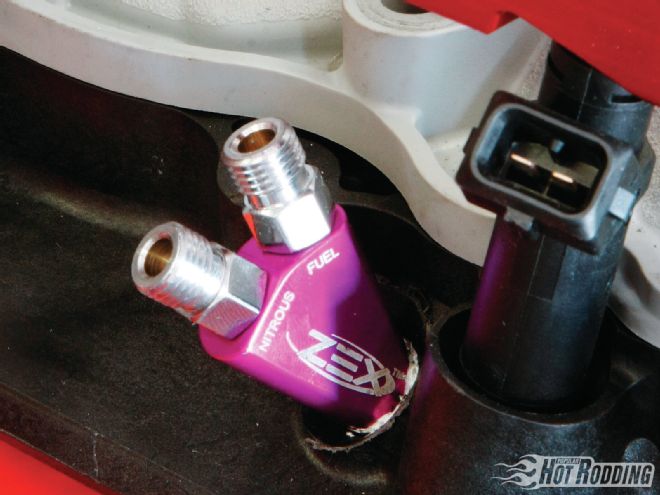 The LSXR is designed to be friendly to any power adder, so it features thick bosses to mount wet fogger nozzles like our ZEX LSX direct-port nitrous system (PN 82032, $1,329.95) which is adjustable from 75-300 hp. Nitrous is simply a tool that allows you to adjust how much and how quickly the engine burns the fuel. If the fuel isn’t there, the power won’t be either, so we’re using a set of 60-lb/hr FAST fuel injectors (PN 306008, $513.95) to ensure the flow is available.
The LSXR is designed to be friendly to any power adder, so it features thick bosses to mount wet fogger nozzles like our ZEX LSX direct-port nitrous system (PN 82032, $1,329.95) which is adjustable from 75-300 hp. Nitrous is simply a tool that allows you to adjust how much and how quickly the engine burns the fuel. If the fuel isn’t there, the power won’t be either, so we’re using a set of 60-lb/hr FAST fuel injectors (PN 306008, $513.95) to ensure the flow is available.
Results: +117 hp, +114.7 lb-ft
“…it would put most muscle cars with decent suspension in the 9s on sauce while still being a perfectly reliable stock engine that returned respectable fuel economy…”
125HP Shot Dyno Test
Everything looked fine on the 75hp shot, so next we upped the “pill” to 125 hp. Things were working well on our high-mileage truck motor, so we stayed with the 91-octane fuel to simulate what the average street guy would be running. This size shot with pump gas would be an ideal combo for someone running this on the street every day. With the same 23 degrees of total timing and the same 10.8:1 air/fuel ratio, we were up over 200 hp from our baseline naturally aspirated run.
6.0L LS LQ4
125HP Nitrous
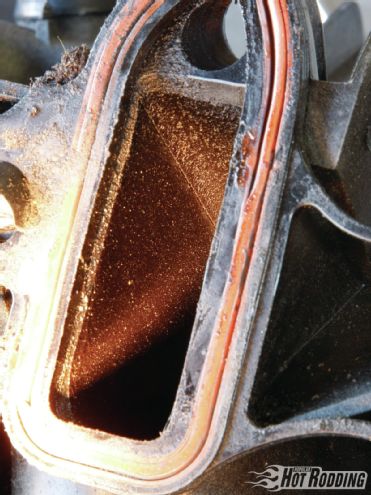 We want to run a wet-style fogger nitrous system since it allows the most precise tuning for large power hits, but the problem with that on the stock truck intake is there is no way to properly mount the fogger nozzles. There isn’t enough room next to the injector and the plastic runners are only a little over 1/16-inch thick.
We want to run a wet-style fogger nitrous system since it allows the most precise tuning for large power hits, but the problem with that on the stock truck intake is there is no way to properly mount the fogger nozzles. There isn’t enough room next to the injector and the plastic runners are only a little over 1/16-inch thick.
RPM TQ HP 3,100 446.1 263.3 3,300 451.0 283.4 3,500 442.3 294.8 3,700 449.9 317.0 3,900 598.2 444.2 4,100 645.8 504.1 4,300 651.0 533.0 4,500 652.6 559.2 4,700 646.5 578.6 4,900 634.7 592.2 5,100 620.1 602.2 5,300 605.4 610.9 5,500 593.9 621.9
Results: +204.9 hp, +203.5 lb-ft
175HP Shot Dyno Test
The ZEX LSX direct-port system uses a unique dual-stage jetting system; there is a set of jets in each of the distribution blocks and a second set of jets in each of the nitrous nozzles that allows the tuner to further trim nitrous and fuel for individual cylinders. The correct combination of jets is listed on the tune-up in the instruction manual. For our 175hp run, we stepped up to VP Racing’s VP100 and pushed the rpm just a little harder. The timing remained at 23 degrees total with the air/fuel ratio at 10.8:1.
6.0L LS LQ4 175HP Nitrous, VP100 Fuel
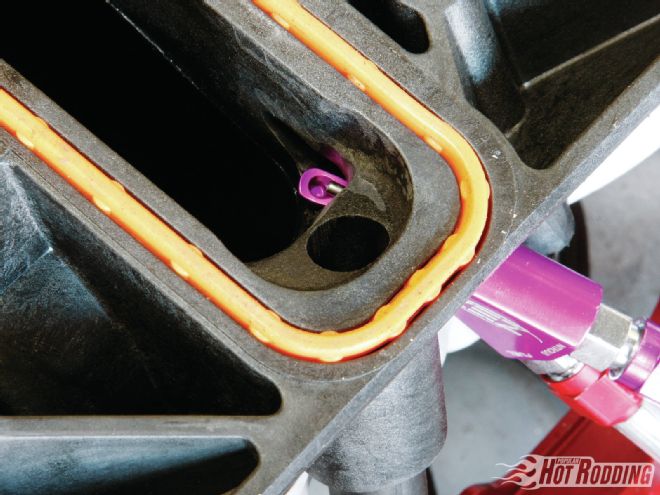 Just as critical to making power with nitrous is the targeting of the nozzle within the runner. We want the nozzle to extend fully into the runner to ensure the fogger can work as intended without puddling in the intake.
Just as critical to making power with nitrous is the targeting of the nozzle within the runner. We want the nozzle to extend fully into the runner to ensure the fogger can work as intended without puddling in the intake.
RPM TQ HP 3,100 444.1 262.1 3,300 448.7 281.9 3,500 452.4 301.5 3,700 465.4 327.9 3,900 640.7 475.8 4,100 707.4 552.2 4,300 703.2 575.7 4,500 707.4 606.1 4,700 696.5 623.3 4,900 691.0 644.7 5,100 674.4 654.9 5,300 658.9 664.9 5,500 639.5 669.7 5,700 624.4 677.7 5,800 620.1 684.8
Results: +267.8hp, +258.3lb-ft
“…the ZEX nitrous system over-delivered on the promised horsepower and torque on every test we ran.”
Where The Money Went Description: Source: PN: Cost: Direct-port fogger nitrous system ZEX 82032 $1,329.95 Salvage yard LQ4 truck engine $900.00 LSXR intake manifold FAST 146302 $953.95 Billet fuel rails FAST 146032-KIT $190.95 60-lb/hr injectors (8) FAST 306008 $513.95 92mm Big Mouth throttle body FAST 54095 $476.95 Total: $4,365.75
200HP Shot Dyno Test
At this level, reading every plug is critical to ensuring the tune and fuel are supporting the nitrous you’re injecting. Ours looked perfect after each pull. To step up to 200 hp, we poured in VP Racing Fuel MS109, swapped to plugs two heat ranges cooler than stock. Macy pulled the total timing down to 20 degrees and leaned the air/fuel ratio to 12:1. We actually ran this test twice, producing consistent numbers, but a touch of flutter at the top end and visible flame from the headers told us we were basically blowing out the spark despite squeezing the gap down to .030 inch. Our LQ4 was maxed out in this form.
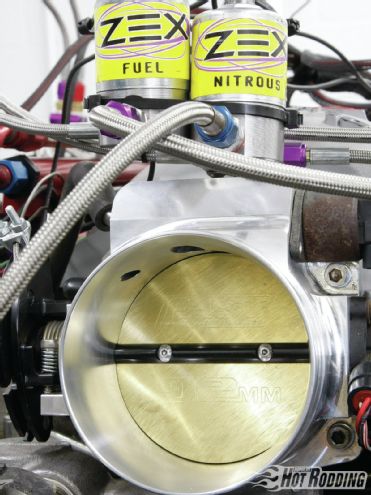 FAST calls this beautiful billet beast the Big Mouth for good reason; it swallows loads of air in a streamlined hurry through a 92mm orifice (PN 54095, $476.95). That will be plenty for our test, but the Big Mouth’s big brother weighs in at 102mm if you need more.
FAST calls this beautiful billet beast the Big Mouth for good reason; it swallows loads of air in a streamlined hurry through a 92mm orifice (PN 54095, $476.95). That will be plenty for our test, but the Big Mouth’s big brother weighs in at 102mm if you need more.
6.0L LS LQ4
200HP Nitrous, VP MS109 Fuel
RPM TQ HP 3,100 449.5 265.3 3,300 456.6 286.9 3,500 457.5 304.9 3,700 462.5 325.8 3,900 610.2 453.1 4,100 801.6 625.8 4,300 790.6 647.3 4,500 781.5 669.6 4,700 772.1 691.0 4,900 755.8 705.1 5,100 740.9 719.5 5,300 724.0 730.6 5,500 701.9 735.0 5,700 675.2 732.8 5,800 667.0 735.9
Results: +318.9hp, +352.5lb-ft